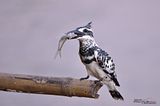This is quite a delayed post. The afternoon of October 23 had me walking through the familiar track around Sekino-E. It was another dark overcast day and the rain did pour down late that night. I was walking totally unaware when this Tundra Bean Goose (Anser fabalis serrirostris) swam out of the corner right into my eyesight, a lifer! The bird was swimming alongside a domestic male Mallard in the pond near the lotus field. After just recently saw Greater White-fronted Geese in Kitsuki, I wonder why this winter brought Kyushu so many geese.
I am sure that the Mallard is domesticated since I used to see a flock of them with some hybrids staying in this pond. So I started to question if the goose is also domesticated or not. It was very tame and didn't fly away even when I tried to chase it. I finally got the answer when the bird eventually flew out towards the sea at dusk. It has such a strong and rapid flight, so my question was finally answered. It is quite unbelievable how a wild bird can sometimes be really tame.
I am sure that the Mallard is domesticated since I used to see a flock of them with some hybrids staying in this pond. So I started to question if the goose is also domesticated or not. It was very tame and didn't fly away even when I tried to chase it. I finally got the answer when the bird eventually flew out towards the sea at dusk. It has such a strong and rapid flight, so my question was finally answered. It is quite unbelievable how a wild bird can sometimes be really tame.







Tundra Bean Goose (Anser fabalis serrirostris)





I didn't even have to crop these images. The bird looked a bit exhausted as it often closed its left eye. I wonder if that's part of the reason why it chose to come down here in a city where most good migrants choose to fly pass very quickly. After checking through the guidebook and the internet, it turns out that the bird is the subspecies "serrirostris" of the Bean Goose. Some people separated it as Tundra Bean Goose. It is one of the 2 subspecies wintering here in Japan. Another is the Taiga Bean Goose (Anser fabalis middendorffii).





Here's the male Mallard it was staying with









Tundra Bean Goose can be well separated from the Taiga Bean Goose by its much shorter and stockier bill and head structure. Taiga Bean Goose has a much longer and slender bill than the stout short bill of the Tundra. The Tundra also has a smaller body and shorter neck as well. The bird here still seems to be an immature since the orange spot on its bill is still very faint.
Actually the subspecies "middendorffii" has recently been proposed for splitting into a totally new species, Middendorf's Bean Goose, as it looks very different from both the Tundra type and the Taiga type "A.f.fabalis", the nominate race that winters mostly in Europe. Both the Tundra and "fabalis" Taiga have short and stout bill with much shorter neck than the "middendorffii".
Actually the subspecies "middendorffii" has recently been proposed for splitting into a totally new species, Middendorf's Bean Goose, as it looks very different from both the Tundra type and the Taiga type "A.f.fabalis", the nominate race that winters mostly in Europe. Both the Tundra and "fabalis" Taiga have short and stout bill with much shorter neck than the "middendorffii".




















.jpg)

6 comments:
Absoluteley great pictures of the Bean Goose A. Over here they are extremely difficult to get close to as they always hang out with many wary pink-feet and thus fly off at the first sight of people. i didn't know about the further proposed split of middendorfi either - more cats among the pigeons as the whole lot can be difficult to assign to subspecies.
Great serie, love the Tundra Bean Goose images, a very nice bird well photographied ;)
Great Geese shots there.........
I usually see a few of these each winter, not sure which subspecies, I should pay more attention I think.........
Beautiful sighting and nice pictures... i mean, do you really think that they look all so different these geese? Sometime I'm lost!!
Thanks a lot everyone! I looked at your Bean Geese photos and they were all Taiga Bean Goose A.f.middendorffii, Stu.
Three Bean Geese turned up here in Hong Kong on Oct 30th after some stiff northerly winds.....
Not sorted whether they were Tundra/Taiga.... distant pics on HKBWS website here:
http://www.hkbws.org.hk/BBS/viewthread.php?tid=12419&highlight=Geese
Post a Comment